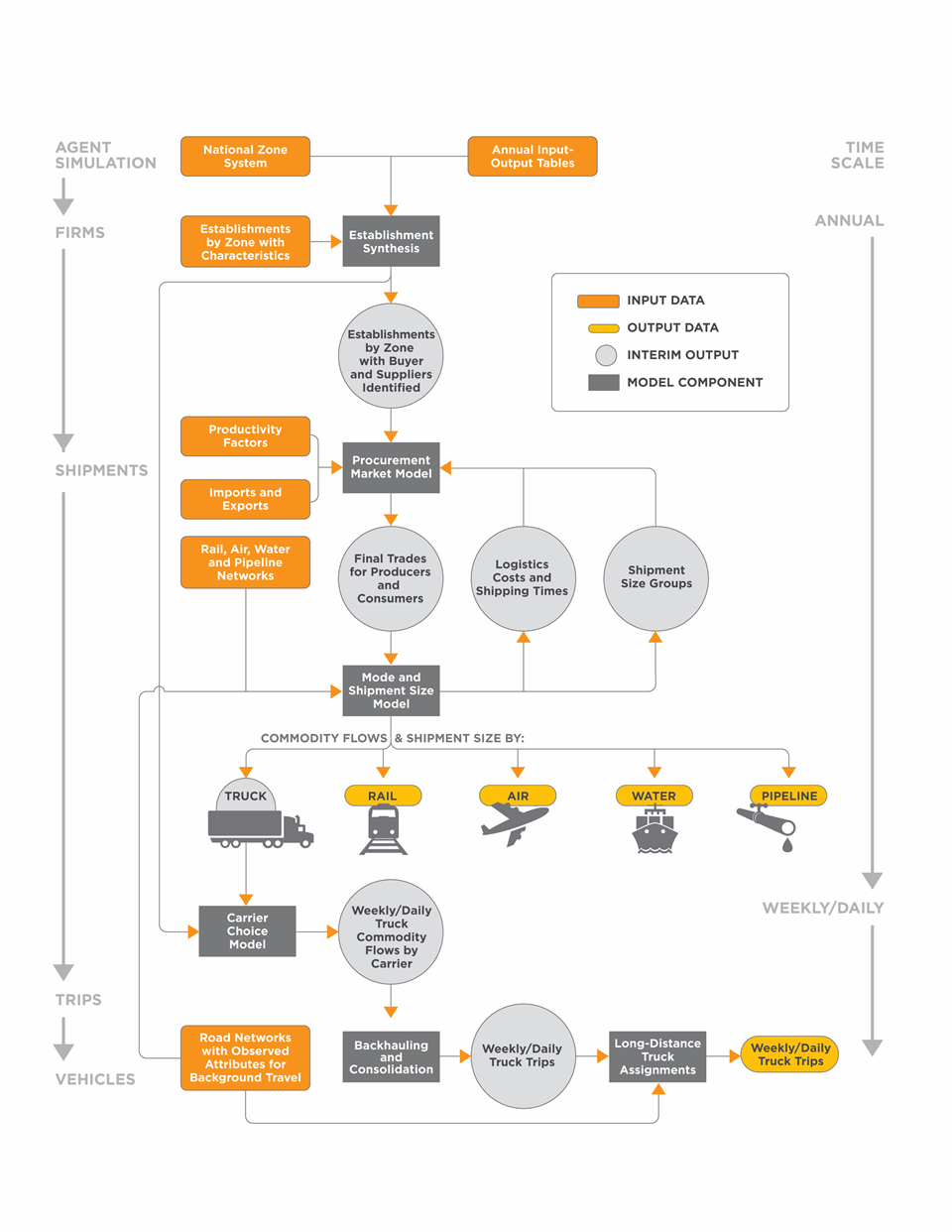The United States now has a working behavioral-based national freight model to evaluate, by shipment mode, the economic and business relationships across all industries and firms. Consultants, universities, and expert panel members from across the continent and Europe advised on the model’s direction and potential applications of this first-of-its-kind exploratory research study to design and build a behavioral-based national freight model.
“It’s been exciting to test and implement innovative approaches,” said Maren Outwater, PE, when discussing her work with the Federal Highway Administration (FHWA). Maren has served as Principal Investigator for the first two phases of the project and is currently leading its third phase.
The first two phases researched how to design and build the national freight model. The third phase is calibrating and validating the model to ensure it is a functional, practical tool to forecast national freight movements across a range of scenarios.
After the third phase, practitioners will be able to use the model to: 1) obtain long-distance freight movements from the national freight model for statewide models; 2) analyze how national economic changes might affect freight movement in or through a state; 3) develop a statewide freight model using the national freight model’s open-source platform; 4) evaluate freight investment studies at a multistate (megaregional) level; and 5) assess private sector and global trade decisions on the Transportation Infrastructure Investment Plan.
Here’s what went into creating the model, what makes it unique, and what comes next.
The national freight model includes new models and offers innovative capabilities to states and regions
Getting to this implementation point has required agility and focus on the part of the project’s researchers. Given the work’s advanced and exploratory nature, the study team overcame novel challenges while designing the model, which includes several unique improvements and enhancements never used in a model built at this scale or complexity.
For instance, the national freight model includes a joint mode choice and shipment size model (see figure below). While not unique in and of itself, the model used for this research study is the only one in existence that has been estimated using US data; others have used similar data but from outside the United States.

The structure of the national freight model includes several important innovations that will aid practitioners.
The national freight model includes several other important innovations:
- A new firm synthesis model identifies which establishments belong to which firms.
- A new carrier model allows for greater distinction in how smaller/larger firms move goods.
- A new backhaul consolidation model helps model goods movements by vehicle type and specifically captures empty trucks returning to their home base.
The data used by the study team came from the Commodity Flow Survey (CFS), which is conducted by the US Census Bureau every five years. The 2012 CFS was used as the latest available detailed CFS, although preliminary 2017 data are now available. The CFS offers a tremendous amount of data on goods shipped across the United States.
Prior to the national freight model, FHWA had funded similar regional-level research that RSG led with the Chicago Metropolitan Agency for Planning. Using the Chicago work as a starting point, RSG had applied some of these concepts to analogous work done at the statewide level in Florida. Subsequent projects in Baltimore and Portland, Oregon, focused on implementing long- and short-haul model components as well as integrating long- and short-haul movements.
The national freight model approach was a culmination of much of RSG’s work in this area. FHWA’s support for this research also enabled RSG to complete regional freight modeling projects in parallel with this national-level research and develop innovations that those at the state or local level had not been able to fund. The findings of this national-level research can be adopted by states or regions with existing freight models.
The national freight model’s core strength lies in its ability to help practitioners develop and plan for multiple scenarios
The completion of the national freight model’s research and design phase comes at an uncertain time for freight movement in the United States and across the globe. The world in 2020 looks markedly different than it did in 2014 when the study team first proposed its approach to behavioral-based freight modeling at a national scale.
The trade war with China and the COVID-19 pandemic have disrupted supply chains and normal business operations for thousands of firms. Drones, which were once viewed primarily as a hobby, have also emerged as a viable delivery service mode in some cases.
These situations are exactly the types of changes the national freight model was designed to accommodate and help practitioners plan for. The national freight model’s disaggregate structure means it can simulate individual shipments at a firm level. This method produces a more accurate result than forecasts that use an aggregate method, which offers less granularity, especially for industries with smaller market shares.
This specificity means the national freight model can more effectively model scenarios related to trade wars or supply/demand changes due to COVID-19. With trade policy, the national freight model will allow users to enter assumptions related to either an increase or decrease in trade by country. With COVID-19, the national freight model will help practitioners forecast changes for industries or companies by, for example, changing assumptions in the model related to the demand for online delivery of goods.
The national freight model will help practitioners account and plan for most changes that have occurred in recent years through its powerful scenario modeling capabilities. This is one of the key benefits of having this type of model at the national level; practitioners can hypothesize myriad futures in the face of great uncertainty and change.
From the theoretical to the practical: writing the national freight model’s next chapter
The third phase will transform the study team’s research into a model that FHWA can use in concert with practitioners to forecast freight movement.
The final model and its software (rFreight) are open source, which means all states and regions have access to it. Agencies at the regional or state level will be able to look to and evaluate freight flows from the model, which will aid in their assessment of future policies and investments. States will have the option to adopt the national freight model’s approach or obtain the freight flows and volumes from the national freight model as input for their own evaluations.
Ideally, the core structure of the behavioral-based national freight model will endure for some time. Periodic updates to the model using new data as these become available will further enhance the appeal of the model to states or regions and maximize its longevity and utility.
The implementation phase of the national freight model is important to the continuation of the study team’s work. It offers practitioners additional clarity into future freight movement patterns, thereby promoting the continued stability and resiliency of the national transportation network.



